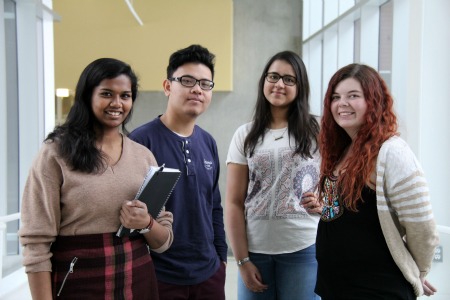
ESS President Sarah Elder (far right) with ESS VP Sushmitha Karunakaran, first-year engineering student Aishwarya Venkit and second-year petroleum engineering student Meor Hashim.
(Edmonton) Engineering Students' Society President Sarah Elder has been appointed to a national advisory council of female student leaders established to advance diversity and inclusiveness in their schools and in industry.
Established by BMO Financial Group and Catalyst Canada-a leading nonprofit organization established in 1962 to expand opportunities for women and business around the world-the BMO Millennial Leaders Advisory Council comprises 30 female student leaders from across the country. Millennials are projected to make up 50 per cent of the global workforce by 2020. BMO and Catalyst is consulting with the Canadian group and learning more about their ideas on leadership and inclusion in the workplace. And in kind, BMO and Catalyst are helping student leaders nurture a culture of inclusivity in their schools.
It's a perfect arrangement as far as Elder is concerned. She has made diversity and inclusiveness a major focus of the ESS this year. Combine that with the fact that three ESS members attended a fall conference on diversity hosted by the Canadian Federation of Engineering Students, and you can see students embracing the concept of diversity and inclusiveness.
Diversity within the ESS and in the Faculty of Engineering has been growing over the years, Elder says, but she wants to strengthen the culture of inclusion.
Examples of an inclusive environment start at the highest level of the ESS. Of 10 members of the senior executive, six are women. But Elder says the appointments weren't made for the sake of parity.
"Quotas don't work-goals do," Elder says. "So there should be a goal that there is a mix, that there's a good representation of gender and ethnicity but I would never want to say there has to be a certain mix-it is merit based and we also see a consistent trend lately that women are more involved not just on the senior executive but also within ESS they are very likely to get involved. It's happening organically."
That doesn't mean it's mission accomplished. Elder is so dedicated to change that she is quitting her job ("a job I love," she notes) so she can dedicate more time to the ESS in her final semester as an engineering student.
This year, she's busy meeting with second-year students, mentoring them to become more involved in student life and the ESS.
"We're building leaders younger and sooner so they will have the ability to bring about change."
Elder has some ambitious goals for engineering students, including working with the faculty to establish an entrepreneurial studies stream, to create a sort of "maker space" where engineering students can prototype projects they are working on, add more student club space and even venture into revenue-generation for the ESS.
Other engineering students are taking the movement seriously too. Sushmitha Karunakaran and Anton Sura share the newly created position of ESS vice president of services, overseeing student services.
Karunakaran, who attended the national conference on diversity, says engineering students are the U of A are already a diverse group. "That's a good thing because engineering is about solving problems in a social context," she said.
But more can be done to inspire students to be more involved and to create change. One way of doing that is by connecting students with role models. One idea is to reinstate panel discussions in which engineers address engineering students.
"One thing we are considering is holding a panel of prominent female students, female professors, and engineers in training to talk about how they overcame barriers, and provide support and to serve as role models," she said, adding that the result would be to reduce the "sense of isolation" some engineering students can experience.
"I think our takeaway from the conference is engineering outreach and getting young girls to be interested in engineering," she added.
Meor Hashim, a second-year petroleum engineering student, and Aishwarya Venkit, a first-year engineering student, also attended the conference. Hashim says panel presentations on breaking the stereotypes of engineering are effective and as ESS co-ordinator of National Engineering and Geosciences Month student activities, he's hoping to help shatter some stereotypes.
Venkit says that after returning from the conference, she has been able to initiate conversations with fellow students about diversity in engineering and what it means. "It's our responsibility to pass that along," she said. "Starting a conversation about diversity isn't a difficult thing to do."